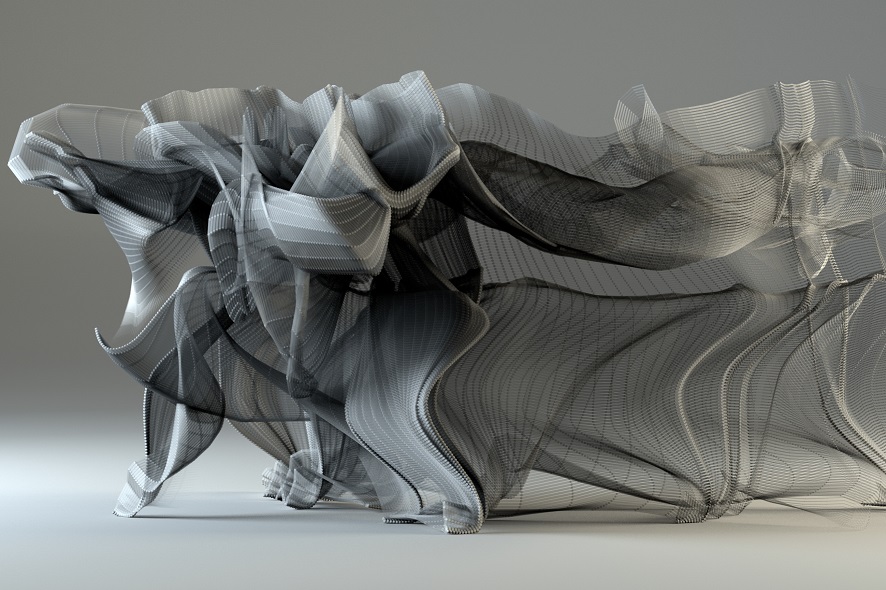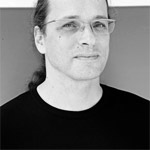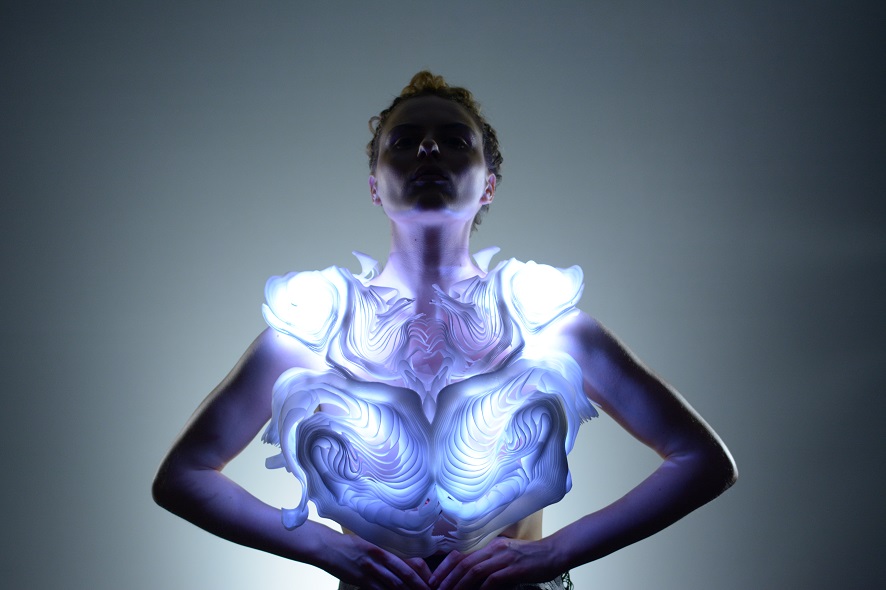What makes a person a human being? What’s the essence of a machine, and what about digital data? These are questions this year’s Ars Electronica Festival—theme: Artificial Intelligence – The Other I—aims to shed light on. The exhibition treating this topic, POINT ZERO, is a search for the essence of human, machine and data in the depths of POSTCITY Linz.
In a prior interview, Gerfried Stocker, artistic director of Ars Electronica, gave us some fascinating food for thought about the festival theme. Here, he talks about artists’ takes on artificial intelligence, the POINT ZERO theme exhibition and his personal highlights.

Gerfried Stocker. Credit: Florian Voggeneder
How are artists dealing with the subject of artificial intelligence?
Gerfried Stocker: There are a few thematically well-defined strategies or approaches that artists are taking to this topic. One major area in which artists are especially interested is the ethical and philosophical dimension that emerges around a confrontation with artificial intelligence. This has to do with the question: What is intelligence? We are actually not in a position to even describe what intelligence is. We don’t know where intelligence forms in our brain and how it’s ordered. Inextricably interwoven with this is the matter of the core or the essence of being a human being. This ethical-philosophical question, the most central issue we face, actually addresses what artificial intelligence is to a far lesser extent than what it means to be human.
This, in turn, is connected to a major thematic area that also entails a juxtaposition of machine intelligence to human intelligence. What is artificial intelligence, and what is biological intelligence? And there are correspondences to this pairing in artists’ considerations. The third area has to do with possibilities such as machine learning that we as artists have had at our disposal or been able to use for our own artistic intentions.
So, on one hand, there’s the very central, ethical approach via the question of what is actually the essence of being human and human intelligence; and connected to this is the very concrete, scientific-technological question; and then, on the other hand, there’s a third area in which technologies like machine learning are being utilized in artistic work.
And amidst it all are two poles: the affirmative and the critical. Among the artistic approaches, there are apocalyptical scenarios just as there are elaborations on how artificial intelligence can be deployed in positive ways that are compatible with humankind.

“Kitty AI” by Pinar Yoldas will be part of POINT ZERO. Credit: Pinar Yoldas
What’s to be gained by the artistic confrontation with the subject of artificial intelligence?
Gerfried Stocker: These two artistic stances, affirmative and critical, are interrelated. What’s most beneficial is that, as usual and in the expected way, this artistic confrontation, the formation and expression of views by artists, is to a much greater extent the outcome of a process of reflection than the abbreviated treatment purveyed in the mass media. I believe that this is one of the key, decisive reasons why we’re dealing with this topic at our festival. Amidst all the hype or this state of hysteria that has accrued around the subject of artificial intelligence, more shades of gray have to be added to the prevailing black-and-white picture. This is one of the contributions art can very effectively make. And ever since the early days of Ars Electronica, this is precisely what we’ve seen as an essential part of our festival’s mission: Working on the emergence, depiction and presence of more nuanced, complex images that go beyond simplistic representations.
“Ready To Crawl” by Hiroshi Sugihara will also be part of the exhibition.
How are the various approaches to artificial intelligence reflected in the theme exhibition?
Gerfried Stocker: The theme exhibition is entitled POINT ZERO and divided into three parts: Human.0, Machine.0 and Data.0. The title is a reference to the essence, to the core from which everything comes and to which everything can be reduced. For example, what is the core or the essence of that which describes us as human beings? Whereby, of course, homo sapiens is a special biological case. Machine.0 investigates the essence of that which emerges from technology, from the mechanical-electronic, from the machine. Data .0 is the question of what is—or would be—the essence of something engendered purely by digital data.
We often speak of digital-born material—that is, things that weren’t produced with analog media and subsequently digitized, but rather works (done in artistic disciplines or other fields) that originated directly on the computer. What inspires people’s imagination is that possibilities which can be expected to become reality in the near future will have reached such a level of sophistication that, at least in a rudimentary form, something that has a subjective character will have come about from digital data, from code or software.
In the world of machines, we are still far removed from the point at which it would be possible to say that this machine world has produced something that, qualitatively speaking, is even remotely comparable to that which nature brings forth. But we’ve come a long way—for instance, there are machines that can move very well and even fly. In the world of data, we’ve only just gotten started. Now, the question is: What’s the essence of something that is digitally born?

Tobias Gremmler will show selected works. Credit: Tobias Gremmler
Speaking of digitally born: Is there already talk of things that arise without human intervention?
Gerfried Stocker: Aside from it being very interesting to ponder such matters as an intellectual-philosophical exercise, this question actually has no relevance whatsoever because it’s based upon such huge hypotheses. The time in which one could really say that something might emerge without a human being making it happen is still too far off.
What we’re frequently overlooking in these apocalyptic scenarios in which technology, artificial intelligence and robots are superseding humankind is the simple fact that there’s not a single piece of technology on this planet that wasn’t made by human beings. This means that, in any case, it won’t be the machines that harm us or take over from us; it’s what we inflict on ourselves. We have to concentrate on what we do now, and how to nurture the development of these possibilities so that this doesn’t lead to harming human beings or making us useless. This is our true responsibility.
Thus, the connective element in this whole exhibition is actually the human being…
Gerfried Stocker: The factor that connects and that acts.
This brings us back to the festival theme, which refers to “The Other I” for very good reason.
Gerfried Stocker: Indeed! The Other I” is just another way of saying: Let’s take a long, hard look at our visions, fears, possibilities and fantasies about artificial intelligence as a way to consider who we are, what we’re doing, who we want to be and what we have to do to get where we want to go. It’s up to us, what we make of this technology.
Tell us about some of the highlights we can look forward to in the POINT ZERO theme exhibition.
Gerfried Stocker: The most fascinating thing about the projects in “Point Zero” is how they intersect and overlap this encounter with the essence of the machine, the human being or the data.
“cellF” by an Australian artist named Guy Ben-Ary is definitely one of the highlights. It’s possible to prepare cells in such a way that they become pluripotent stem cells that can subsequently be made to develop in a specified direction. This is exactly what the artist did—he developed somatic cells into neuronal cells. This became a cell culture that’s a sort of super miniature brain. Certainly, to speak of a brain here is highly speculative, since an actual brain consists of a huge number of cells. So what developed here was, in a symbolic, small format, a neuronal network made up of cells of the artist’s body. It is, so to speak, a symbolic, externalized I, another I that the artist utilizes as a sort of synthesizer. When these cells are active, they don’t reach the point of producing consciousness, thoughts or brilliant theories, but they do perform the essential activities of our brain or our intelligence: namely, constantly creating interconnections, sending signals back and forth. Ben-Ary converts these signals into sounds. He implements his externalized, second I as an instrument for installations and performances.
“Reading Plan” by Lien-Chang Wang is an extraordinarily beautiful project, a large-scale installation in which robots browse through books in a sort of classroom. Visually, it’s incredibly beautiful!
“Archive Dreaming” by Refik Anadol is a work executed on the basis of deep learning. It’s an artistic project that’s an outgrowth of what are currently the most proficient possibilities of machine learning, whereby enormous quantities of data or information from archives are fed into a neuronal network. The artist has created a space in which visitors can immerse themselves and observe these processes. It is probably one of the best-possible means that has even been created to experience how this high degree of complexity and information processing density works in such a complex neuronal network. It’s an incredibly impressive artistic experience. It truly is as if you climbed inside the brain of a self-learning machine and could move around within it.
Akinori Goto’s works are likewise among the highlights. He transforms people into data by means of motion capturing. He digitizes a dancer’s movements and uses the resulting data to create a 3-D sculpture that depicts the motion and not the body. Then, the motion tracking data are projected into the sculpture as tiny anthropomorphic figures. In his new work that’s premiering at the festival, he gives installation visitors the possibility of touching and moving these 3-D objects. The way the installation visitor moves the object determines how the figure is projected into it. So, this ultimately brings you back to human motion, whereby you can take this sculpture in hand and observe this sequence of movements or transformations from body to data to machine and back to human action. This work is enchantingly beautifully and, when you see it, superbly simple to understand.
Another highlight is “MoRFES_02” by Maria Yablonina. This work consists of two robots spinning a web in a room. The robots move back and forth between two walls, affix a string to a wall hook, give the string to the other robot, affix it again … and thus weave a huge web for themselves in the room. The technical execution is lovely to behold.

Gerfried Stocker is a media artist and telecommunications engineer. In 1991, he founded xspace, a team formed to carry out interdisciplinary projects, which went on to produce numerous installations and performances featuring elements of interaction, robotics and telecommunications. Since 1995, Gerfried Stocker has been artistic director of Ars Electronica. In 1995-96, he headed the crew of artists and technicians that developed the Ars Electronica Center’s pioneering new exhibition strategies and set up the facility’s in-house R&D department, the Ars Electronica Futurelab. He has been chiefly responsible for conceiving and implementing the series of international exhibitions that Ars Electronica has staged since 2004, and, beginning in 2005, for the planning and thematic repositioning of the new, expanded Ars Electronica Center. January 2009 saw the opening of the expanded Ars Electronica Center.
The POINT ZERO exhibition will run during the Ars Electronica Festival September 7-11, 2017 in POSTCITY Linz. To find out more about the festival, follow us on Facebook, Twitter, Instagram et al., subscribe to our newsletter, and check out our website at https://ars.electronica.art/ai/en/.
